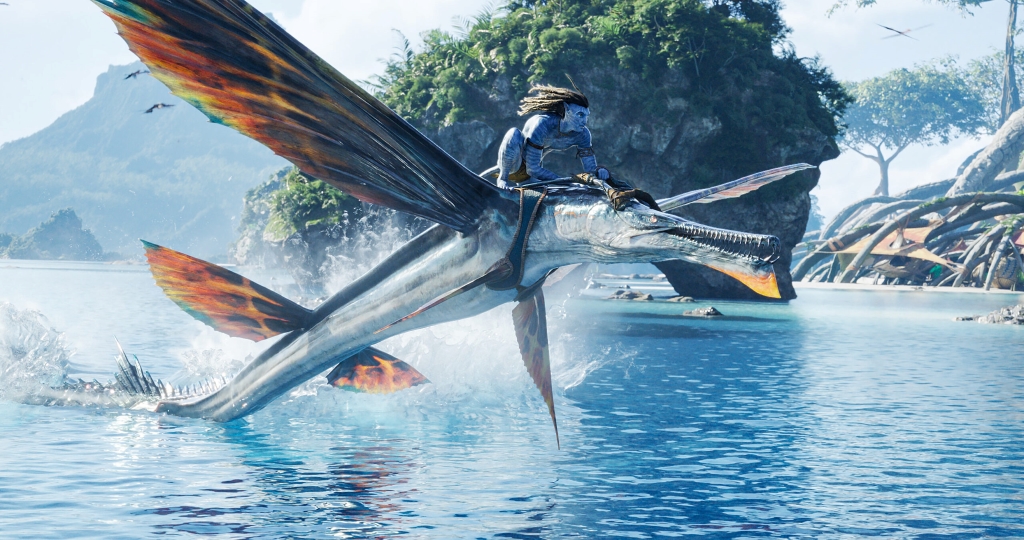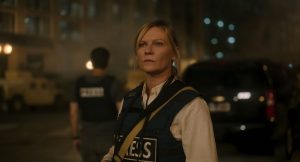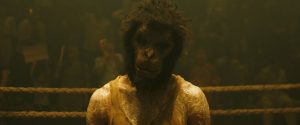Reviews include Irena’s Vow, The Beast, and Before I Change My Mind.
TFCA Friday: Week of Dec. 16
December 16, 2022

Welcome to TFCA Friday, a weekly round-up of film reviews and articles by TFCA members.
In Release this Week!
Avatar: The Way of Water (dir. James Cameron)
“It deserves attention, if only for its show-stopping marine creatures,” writes Peter Howell at the Toronto Star. “The liquid subtitle tips to the film’s outstanding immersive qualities and environmental concerns. Canadian director/co-writer James Cameron is at his best in the water, as seen in Titanic, The Abyss and his real-life undersea exploration of the Mariana Trench depths. He waited to make this film until technology advanced to render his water scenes, real and imaginary, as convincing as possible.
“The movie is indeed an event,” declares Jim Slotek at Original Cin. “When it’s in the water, which is most of the time, there is a haunting beauty to Cameron’s second effort. The effects in the original – while ‘wow’ producing in 2009 – were largely of the big bam boom variety, as we watched colonizing humans go to war with the Na’vi inhabitants. While The Way of Water could have easily lost an hour from its three-hour-plus running time, it would have been a shame to lose its most magic moments, the stuff that makes it different.”
“The Way of Water is blockbuster entertainment at its best – with special effects, heroics, a fight to the death at the climax between hero and villain with death not shied away,” says Gilbert Seah at Afro Toronto.
“The most exciting sea creatures are the tulkun, grand animals that resemble whales and have the sensibility of dolphins. The Metkayina are their cherished friends: they sing to each other. In a special scene, one of Sully’s kids, Lo’ak makes friends with a rouge tulkun. You know that will help some time in the future,” writes Marc Glassman at Classical FM. “All good things must come to an end. Cameron has to give us a plot, which feels a bit wonky. Given that Sully has gone underground, or at least under water, why not leave him alone? But no, the plot dictates that Colonel Quartich must come after him and his family, all guns ablazin’.”
“OK, fine; the alien vistas, planetary eclipses and massive technology all look pretty amazing on the big screen,” admits Chris Knight at the National Post. “I saw The Way of Water in a preview that was IMAX 3D; it’s also available in HFR, or high frame rate, in some locations. This was both thrilling and a little distracting if you’re not used to the clarity of the image. Ironically, hyper-real, you-are-there footage takes some getting used to. But fear not. We have years of sequels ahead. Neither Jake nor his adversaries are going anywhere soon.”
“[M]uch of Cameron’s film bridges a strange, ultimately beguiling gap between the real and digital worlds,” notes Barry Hertz at The Globe and Mail. “Worthington and the rest of the cast were filmed via motion-capture technology, even during their underwater scenes, and the result is both discombobulating and entrancing. Especially when the film is viewed under Cameron’s ideal conditions: in IMAX 3D, with a variable frame rate of 48fps (or frames per second; the norm is 24fps).” Hertz also chats with the young co-stars of the film, Jack Champion, Trinity Jo-Li Bliss, Bailey Bass, and Jamie Flatters to learn about the challenges of the big shoot. “Well, there was getting over my fear of drowning,” says Bass. “But it was also about being comfortable in your own skin.”
Geographies of Solitude (dir. Jacquelyn Mills 🇨🇦)
“The full name of Hollywood’s industry group and Oscar-granting association is the Academy of Motion Picture Arts and Sciences,” notes Chris Knight at the National Post. “Those last three words perfectly encapsulate director Jacquelyn Mills’ new documentary about the last full-time inhabitant of Nova Scotia’s Sable Island. Geographies of Solitude is a film about science. It is also a work of art.”
“The cinematography captures the weight of nature – the night sky stars are thick and bright, and the winds howl through the grasses and weeds,” observes Anne Brodie at What She Said. “Sadly, its freshwater ponds, crucial for life, are disappearing and who knows what havoc climate change will cause. Mills uses a “contact mic” which enables us to hear the constant buzz of life – in wood, as insects crawl up a plant – fascinating. Consider us lucky to be able to explore this place for 90 minutes.”
“Horses are cinematic—tall athletic creatures that gambol and sprint through nature as their natural desires carry them,” writes Marc Glassman at POV Magazine. “Mills’ camera captures them, nature’s aristocrats, in their splendour but she doesn’t neglect the grey seals, who can be easily consigned to the role of clowns. She allows you to gawk in amusement as they wriggle forward, bellies rolling, from the shore to a sandy bar, where they can hang about, making dorky sounds. Over 100,000 seals have been born and make their home on Sable, likely more. Mills’ wide, poetic lensing catches these Marx Brothers of the sea-loving mammal community in their comic splendour.”
“In keeping with Lucas’s general life philosophy, Mills’s film doesn’t attempt to paint a portrait of one woman, but rather a capturing of the land that woman calls home,” says Barry Hertz at The Globe and Mail. “Using 16 mm film, Mills shoots the sands, seals and serenity of Sable with an abstract yet intimate eye. The sounds of the island’s insects creep onto the soundtrack with a static crackle. The natural materials that Lucas collects are magnified and saturated into hypnotizing images that could feel at home on the other end of a microscope or on the wall of a gallery. And then there are the night skies, starry and seductive.”
“Unquestionably, it’s a beautiful film, shot in 16 mm, with grainy, almost tactile, images and sounds,” observes Liam Lacey at Original Cin. “There is an inky sky, strewn with stars; the silhouette of a horse, mane blowing in the wind, water droplets and scampering bugs, the rustling of the wind and the rumble of waves. It weaves together themes of women’s life choices, our fraught relationship to nature, the art of archiving and the power of awe.”
“Geographies of Solitude is a quiet and meticulously made environmental documentary that educates, mesmerizes and surprises making it the one documentary that has to be seen this year,” writes Gilbert Seah at Afro Toronto.
High Heat (dir. Zach Golden)
“High Heat is executed without much flair and everyone appears to be going through the motions,” admits Gilbert Seah at Afro Toronto. “The fighting scenes are nothing out of the ordinary even the fight in the restaurant kitchen, similar to the one seen in the recent film, The Menu.”
Revival69: The Concert that Rocked the World (dir. Ron Chapman 🇨🇦)
At Original Cin, Kim Hughes looks at the doc with a few words from director Ron Chapman. “For local rock fans,” writes Hughes, “the film feels like an essential if esoteric piece of history, one all but ignored by the mainstream press at the time because, as Chapman notes, ‘It was shortly after Woodstock, and I think there was a certain amount of fatigue in the music press at the time. It was never perceived to be an ‘important’ concert in the leadup to the show, and so there was really no coverage or international attention.’”
“The best moments are the archive footage of live performances at the concert by Bo Diddley, Jerry Lee Lewis and Chuck Berry,” notes Gilbert Seah at Afro Toronto. “The sight of the spectators just dancing and getting high also creates the spirit and liveliness of the event.”
“Revival69 might sit in Summer of Soul’s shadow the way the Harlem fest was obscured by Woodstock. But this look back at 1969 rollickingly revisits the days when Toronto knew how to rock out,” writes Pat Mullen at POV Magazine. “There’s extraordinary footage of the concert and its preparations, too, because D.A. Pennebaker got wind of the show. Shortly after filming Monterey Pop, Pennebaker hiked up to Toronto with his crew and shot the revival from all angles.”
The Whale (dir. Darren Aronofsky; Dec. 21)
“It is deeply painful to see what he has become when under that massive fatsuit, Charlie’s humanity shines forth,” notes Anne Brodie at What She Said. “He’s interested in and intrigued by his seething daughter and endures her hateful taunts without flinching. Still, she keeps visiting. Samantha Morton is vividly real as his ex-wife warns him that their daughter is evil.”
At The Globe and Mail, Barry Hertz chats with The Whale star Brendan Fraser about his transformative performance and finding the confidence to be so vulnerable on screen. “There is still that sense that someone is going to walk up to me, hand me a towel and say, ‘Fraser, get back in the dish pit!’” Fraser tells Hertz. “I don’t ever want to get too comfortable. I want to make sure that I can approach the work with an eager attitude. It is always going to be hard to believe the criticism, and you shouldn’t believe the praise, either. But it’s nice work if you can get it.”
“The Whale admittedly engages in a bit of sizism as it relies on the visual power of Fraser’s gigantic presence for equal doses of black humor and stomach-flipping grotesquerie,” says Pat Mullen at That Shelf. “As Charlie, Fraser could easily give Eddie Murphy’s fat-suited characters in The Nutty Professor a run for their money in the latex department. Aronofsky knows the visual power of his made-up star. Moreover, he grasps how to use the character’s huge size in relation to the small, dank apartment that barely contains him. The Whale offers a transformative experience thanks to the heart Fraser summons from deep within the belly of his prosthetics.”
“Much has been said about Fraser’s performance since The Whale debuted at the Venice Film Festival, and they’re all true,” writes Rachel Ho at Exclaim!. “He brings a sensitivity and dignity to the film where others may have played the audience for pity or comedy. Hong Chau and Sadie Sink both offer incredible performances as well, in difficult and complex roles.” Ho also chats with Fraser about his mighty role, which drew upon advice from the Obesity Action Coalition: “They gave me their stories and testimonials, and in the most candid way. It was moving. It was moving to learn [from them],” Fraser tells Ho. “I noticed from person to person who I spoke to, that their journey began with someone early in their life who was quite cruel to them verbally. Made them feel horrible about who they were. Words have meaning.”
A List of Lists: The Best of 2022
At Afro Toronto, Gilbert Seah picks the top ten films of 2022. Atop the list? He agrees with the Cannes jury and taps Triangle of Sadness: “Satire rules in Östlund’s totally entertaining takedown on the rich and privileged,” writes Seah.
At The Globe and Mail, Barry Hertz lists the ten most overlooked or underappreciated films of the year. Atop the list? 2021’s Golden Lion winner Happening: “Featuring a devastating lead performance from Anamaria Vartolomei and a careful, unblinking directorial eye, Happening is a film of international importance, told with empathy, sincerity and anger,” writes Hertz.
At Zoomer, Nathalie Atkinson has a few holiday book suggestions for film buffs and lovers of classic Hollywood (be sure to check out her round-up of notable titles from the first half of the year).
At POV Magazine, Marc Glassman and Pat Mullen pick the best documentaries of 2022. They agree: there is no better film this year than All the Beauty and the Bloodshed. “Laura Poitras’ profile of controversial, ground-breaking photographer Nan Goldin is remarkable: political, artistic and emotional,” writes Glassman. “Suffused with images from Goldin’s classic photo slide show Ballad of Sexual Dependency and her compelling ruthlessly honest monologues, Poitras’ film is emotionally triumphant, charting an artist’s path towards victory against a ruthless oppressive forces. It’s a well-earned success in a tragic time.”
File Under Miscellaneous – From Whistler to Hollywood
For the TFCA blog, members Marriska Fernandes, Rachel Ho, and Pat Mullen recap the highlights from their trip to the Whistler Film Festival. “There’s nothing quite like being greeted by a mountain view on your way to a film and sitting in the cinema alongside people in snow pants and ski boots. More than most festivals, the location defines the experience. It’s hard to beat movies atop a mountain,” writes Ho.
At The Globe and Mail, Barry Hertz looks at the Hollywood odyssey Babylon and speaks with director Damien Chazelle and star Diego Calva about unpacking movieland’s sordid history: “There was something about having all the studios named in the film being fake that worried me, because I’m not going to buy that this is Hollywood at the time if we’re pretending that MGM isn’t a place,” Chazelle tells Hertz. “I felt that Pitt’s character would be at the biggest movie studio at the time working with the biggest producer of the time. And if I’m going to call that anything other than MGM we might as well not call Hollywood ‘Hollywood.’”
At POV Magazine, Pat Mullen chats with director Alek Keshishian about his Selena Gomez documentary My Mind & Me, mental health, and what’s changed in celebrity since he documented Madonna in Truth or Dare: “When I did Truth or Dare, there were three huge worldwide stars: Madonna, Princess Diana, and Michael Jackson,” says Keshishian. “They did surveys around the world because AM radio was still the primary source of information for underdeveloped and third world countries. Those people had crossed over somehow. Today we’re in a cycle where there are hundreds of stars. It’s all niched out. There’s a much bigger news cycle. The beast is bigger.”
At the Toronto Star, Marriska Fernandes speaks with director Guillermo del Toro about animating the world of Pinocchio: “I think that it is such a natural story for me because I had a very interesting relationship with my dad,” del Toro tells Fernandes. “He was very loving in his own way, but he could be really strict and aloof, and in a second he could change. I made it a point to say, ‘I’m gonna do the opposite of what he did so I will not make the same mistakes with my kids.’ But when my kids became teenagers, they told me I was doing the exact same thing that he did! And I realized I was repeating the same mistake.”
At The Globe and Mail, Barry Hertz slags the Golden Globe voters and breaks down this year’s show/nominations announcement: “If you squinted real hard, it all looked like we were back in the comforting, non-terrifying territory of awards season circa 2019,” writes Hertz. “It didn’t take long for the illusion to wear off, though. A slightly more careful glance at the Globe nominations reveals all the cracks and fissures that underscore why the awards show and its governing body deserved to burst into flames.”
At Complex, Marriska Fernandes interviews Canadian actress Shay Mitchell about her New York-set holiday rom com Something from Tiffany’s: “I think the energy that New York has, especially when you are filming something, is great because people are always watching and you can’t completely stop people from watching your scene,” Mitchell tells Fernandes. “So when you do have that experience, it’s a little exciting to be able to know that you’re live performing for some people that are watching the film, which is what happened. But I love it. I think especially around the holidays, New York is really magical.”
TV Talk/Series Scribbles: Pelosi in Picture
At What She Said, Anne Brodie looks at the documentary Pelosi in the House, which profiles the Speaker: “The heroic and brilliantly effective long-time US House Speaker, Nancy Pelosi’s daughter Alexandra has followed her with a vérité camera for three decades,” notes Brodie. “And it so happens she was with Pelosi and her own son in the Capitol building on Jan 6, 2021. So for the first time, we get full access to what was going on in the safe rooms below and away from the White House as Pelosi, Chuck Schumer, security, and aides attempted to digest the violent melee outside.” 1923 also makes an impressive debut as a western series: “It lives and breathes violence in the lawless west and where white men have gone for violent pleasures like hunting,” writes Brodie. The spy series The Recruit, meanwhile, shows promise: “This has the makings of a riveting binger,” says Brodie, while spy games continue in Jack Reacher. “It’s unique macho fun featuring a kid who just might make it in Hollywood and frankly does better than Cruise.” For old favourites, Emily in Paris returns for a third season: “fans can expect more of the same winning formula,” admits Brodie. “The formula is a tonne of eye candy.”



